Marijuana Growing in Aquaponics – Part 2
By Colle and Phyllis Davis
Read our Three-Part Series on Marijuana Growing in Aquaponics
Marijuana Growing in Aquaponics – Part 1
Marijuana Growing in Aquaponics – Part 2
Marijuana Growing in Aquaponics – Part 3
Marijuana flowering buds (cannabis), hemp plant.
This article will show you the modifications from a vegetable-focused growing to an ‘herb’ favored one. The third and final installation will discuss the method for growing only marijuana in medium-based aquaponics.
Most herbs, primarily basil and mint, prefer a dryer medium to maximize their growth and potency. Creating the right conditions for marijuana requires modifications to the aquaponics grow table, the lighting, and the cycling of the nutrient-laden water.
Please remember, the information in this three-part series on Marijuana Growing discusses growing this herb in a medium based aquaponics system. Any other type of aquaponics system is out of our purview, and you will have to go elsewhere for information specific to your different setup.
We have offered a state-by-state list of US states that allow and those that do not allow growing marijuana in Part 1 of this series.
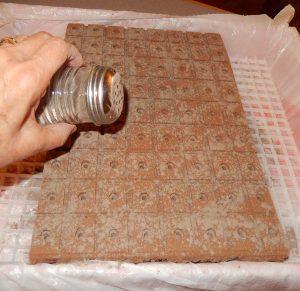 We recommend the use of our Fish-Friendly Mineral Rock Dust to aid in the blossoming of the herb which requires adequate levels of calcium, iron, magnesium, and potassium. The nutrients in fish waste provides ample levels of nitrogen, but it does not have the trace elements that encourage bountiful blossom growth.
We recommend the use of our Fish-Friendly Mineral Rock Dust to aid in the blossoming of the herb which requires adequate levels of calcium, iron, magnesium, and potassium. The nutrients in fish waste provides ample levels of nitrogen, but it does not have the trace elements that encourage bountiful blossom growth.
Building the Grow Table/tray deeper improves the production of herbs. This deeper tray is the biggest single item to increase yield, but it requires planning ahead before you start building. Most medium-based grow tables are between 4.5 inches and 6 inches (11.4cm x 15.2cm) deep.
Making the Grow Tables an inch or two deeper gives the gravel a chance to dry out more between watering cycles. The gravel stays moist, and the bacteria on it are happy, healthy, and willing to give up nutrients to the plants.
- Using 2 x 8-inch (5 x 20cm) sideboards increase the water capacity by 50 to 70%.
- Be careful when sizing your fish tank, so it neither runs over nor gets too low at full cycle capacity.
- A Grow Table that is 7.5 inches deep by 6 feet wide and 16 feet long will contain several tons of gravel and water and requires a solid base or footing to ensure it stays level.
 Improved lighting to ensure 10 to 14 hours of growing time increases the yield of all crops. Adding blue and red LED lights will add to the production of your plants, especially the ones that fruit, such as tomatoes. Too much sun or too long of duration each day will slow the growth because the plants need to rest, just like people. If you want to experiment with longer lighting times, please do so until there is no increase in production.
Improved lighting to ensure 10 to 14 hours of growing time increases the yield of all crops. Adding blue and red LED lights will add to the production of your plants, especially the ones that fruit, such as tomatoes. Too much sun or too long of duration each day will slow the growth because the plants need to rest, just like people. If you want to experiment with longer lighting times, please do so until there is no increase in production.
Flood-and-drain medium-based aquaponics is often misunderstood as to what is best for the plants. Filling the Grow Table to where the water is near the top of the gravel but not noticeable prevents algae from growing. It is better to have the water level too low than ever having the nutrient-laden water exposed to the light.
- The filling and draining are one aspect of this system.
- The other is duration or cycling.
- Many people run their pumps continuously, so the system is always being filled and drained. This method works okay with greens, but not with flowering plants; the medium is too wet.
- The roots of flowering plants need more air on their roots than greens. Medicinal herbs prefer ‘dry’ soil and are prone to mildew and other problems if their roots are too wet.
- We have had the best results by using a single cycle at mid-morning where the Grow Table fills and drains twice, and then the pump shuts off. This single cycle gives the plants plenty of water, and the roots plenty of air.
Fun side note: After about five months of use, the medium (gravel) has a growth of bacteria out of the light that looks like light brown yogurt. It is very moist, soft, and the roots grow all through it.
The next installation will cover pure marijuana growing at its finest — the how and way of a straight medicinal herb production facility.
Good luck, and if you have specific questions on any of the information in this series or want to start your own Portable Farm, please send us an email so we can respond.
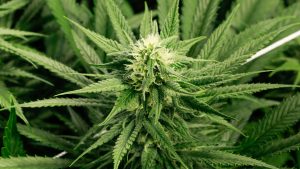
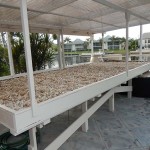
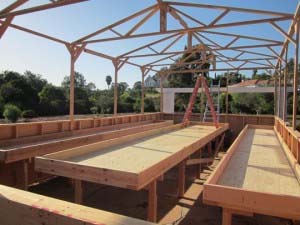
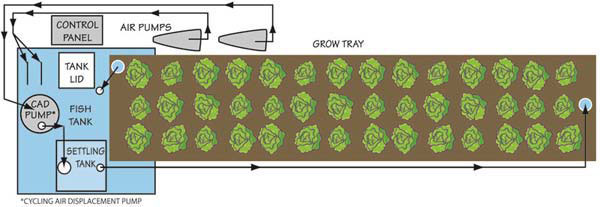
2 comments
would like to have info to develop a biz plan to start a greenhouse farm to produce plants to make CBD oil, do you have a plan template for sale. we have funding to start a farm now but we need a biz plan
Author
Yes, we do have a business plan template for sale. It’s in our book, Commercial Aquaponics Gold. In fact, if you’re interested, I’ll send you the Word document after you purchase the book so you can just fill in the blanks with your information. Here is the link to the book. https://gumroad.com/l/geyXl
Colle and Phyllis Davis